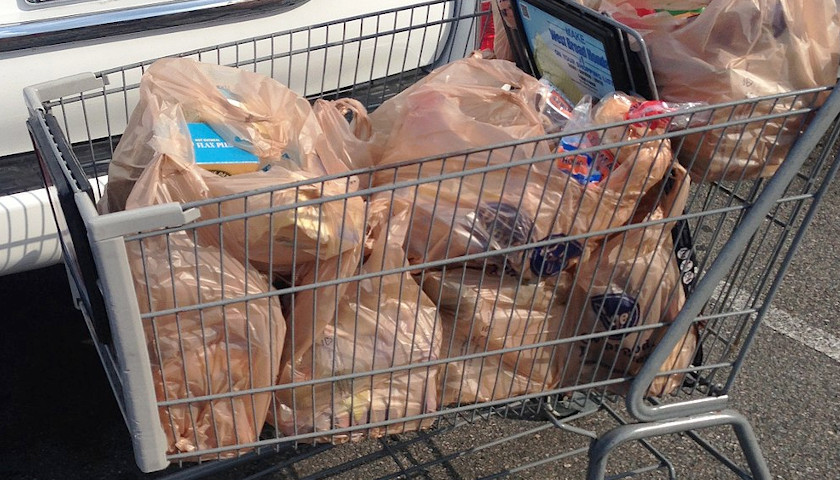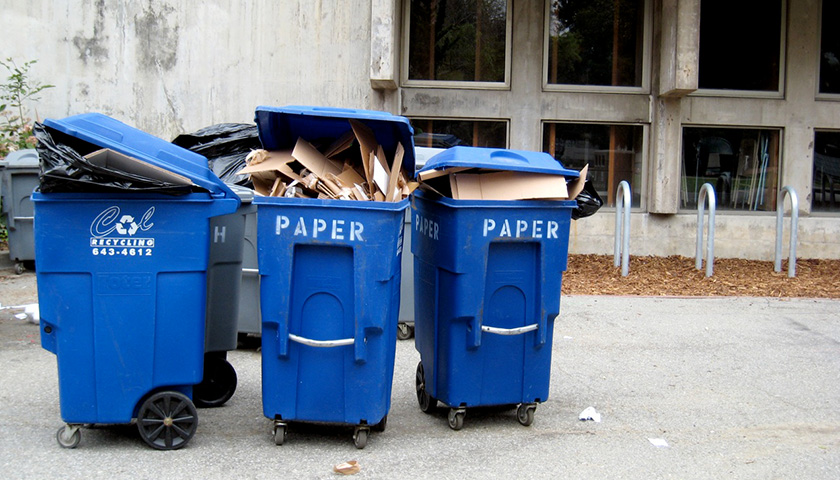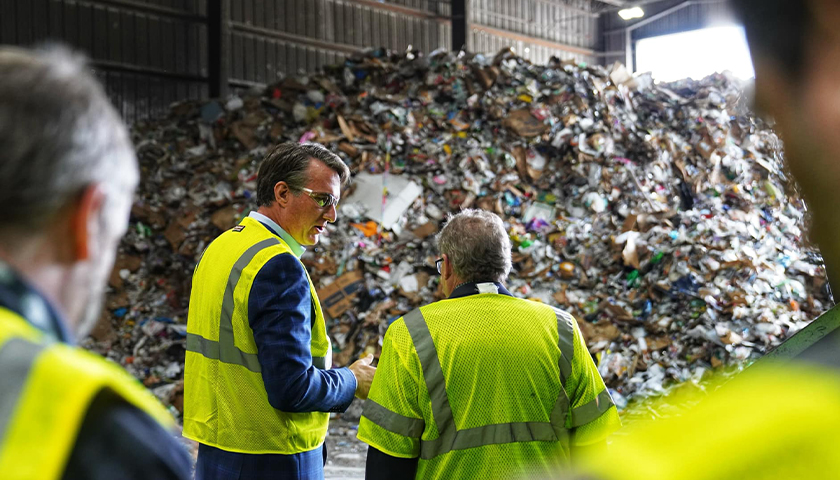by Edward Ring
Back in 2014, the California Legislature passed Senate Bill 207, which banned grocery stores from offering customers “single-use” carryout bags. Permanent implementation was delayed by a November 2016 voter referendum, Proposition 67, which unsuccessfully attempted to repeal the measure. Today it is well-established law.
The only way SB 207 was sold to the grocery industry was through an incentive that permitted them to keep the 10 cents per “reusable” bag that they would be required to charge customers.
California’s pioneering ban is touted by environmentalists as an example for the nation, and progressive cities and states have enacted similar laws. But in reality, it is a misguided policy that does more harm than good.
Today, instead of reusing the free single-use bags to line their trash cans and dispose of their cat litter, Californians now pay 10 cents every time they exercise that privilege. And how does this help the environment, when reusable plastic bags have 11 to 14 times the mass of disposable plastic bags, and hardly anyone reuses them that many times?
Further evidence of the absurdity of laws banning single-use plastic bags is found in a study commissioned by the United Kingdom’s Environmental Agency, which estimated reusable grocery bags made of cotton fabric to have 131 times greater “global warming potential” than conventional disposable plastic bags.
And now consumers have fewer reasons than ever to reuse their reusable bags, because it turns out they’re germ carriers.
This isn’t new information. Common sense would dictate that when consumers purchase grocery items, and allow them to knock around inside a plastic bag, pathogens will be transferred from the surfaces of the grocery items onto the surface of the bag.
Similarly, when consumers set those bags down, such as on the seat or floor of a bus or subway car, or in a shopping cart that someone else is about to use, any pathogens on that surface or on that bag will transfer back and forth—presumably over and over.
And even among those who reuse these bags more than 11 times, or 14 times, or 131 times, how many people disinfect them, every single time?
A recent article entitled “Greening Our Way to Infection” appearing in City Journal, provides an excellent summary of the disease risks attendant to reusable grocery bags. John Tierney exposes the absurd denial of public health authorities, both before and since the COVID-19 outbreak, to the risks of using reusable grocery bags. He writes:
A headline on the website of the New York Department of Health calls reusable grocery bags a “Smart Choice”—bizarre advice, considering all the elaborate cautions underneath that headline. The department advises grocery shoppers to segregate different foods in different bags; to package meat and fish and poultry in small disposable plastic bags inside their tote bags; to wash and dry their tote bags carefully; to store the tote bags in a cool, dry place; and never to reuse the grocery tote bags for anything but food.
This is the world the green extremists want us to live in. Not only shall we reuse our reusable plastic bags more than eleven times, just to break even on the “carbon footprint” vs. a disposable plastic bag, but we shall “segregate different foods in different bags; to package meat and fish and poultry in small disposable plastic bags inside the tote bags; to wash and dry tote bags carefully; to store tote bags in a cool, dry place; and never to reuse tote bags for anything but food.” And cat litter.
The Irrational Extremes of Recycling and Reuse
While recycling is both profitable and green in certain cases such as with newsprint and aluminum, for most garbage it is neither. Plastics, bags and all, are a compelling example of this. For starters, there is no factual basis for the argument that plastic must be recycled because we may eventually run out of petroleum. This is easily documented.
According to OilPrice.com, in 2012 “plastics production accounted for about 4 percent of global oil production.” Four percent. According to the BP Statistical Review of Global Energy, over the past 20 years, proven oil reserves increased faster than consumption. In 2018, there were 1.7 trillion barrels of proven oil reserves worldwide, up from 1.1 trillion barrels in 1998. Plastic, which can also be made out of natural gas or coal, will never run out of the raw materials required for its manufacture.
As for plastics accumulating in the environment, the ocean in particular, much of it comes from fishing nets. One of the largest accumulations of ocean plastic is the Great Pacific Garbage Patch, a collection of concentrations of marine debris in the North Pacific Ocean created by ocean currents. According to Sea Shepherd Global, nearly half of the plastic in these areas come from discarded fishing nets, and “more than 70% of marine animal entanglements involve abandoned plastic fishing nets.”
As for the source of ocean plastic coming from sources on land, a report in USA Today cites a study published in the journal Science that estimates 242 million pounds of plastic waste are discharged by Americans into the oceans each year, and that the total discharge of plastic waste into the oceans, worldwide, is between 8 to 12 million tons.
A quick, somewhat innumerate read of those numbers might incline one to believe that America is the prime offender, but that would be wrong. Once pounds are converted into tons, it turns out that plastic waste from America, at most, constitutes only 1.5 percent of the plastic trash currently going into the world’s oceans.
This is where it becomes problematic to focus on recycling and reuse, rather than containment in landfills. Because even in America, it is a costly indulgence to recycle most of the waste stream. To emphasize recycling in developing nations is futility. The scarce economic resources of developing nations in Africa and Asia would instead be much better used to develop landfills.
There is No Shortage of Landfill Capacity
One of the earliest serious intellectual revolts against the modern recycling industry came in an in-depth 1996 essay in the New York Times Magazine entitled “Recycling is Garbage.” Authored by the same John Tierney who recently joined City Journal after more than two decades as a reporter and columnist with the New York Times, it exposes how misguided environmentalism and government subsidies corrupted the waste management industry.
In his 1996 essay, Tierney described how environmentalist journalists and activists convinced the nation that if something wasn’t done, and soon, Americans were destined to be “buried alive” under the mountain of trash they were creating. He explained that most materials in garbage are not worth recycling, but that politicians are now afraid to oppose recycling. He explained that modern landfills are now required by federal law to be “lined with clay and plastic, equipped with drainage and gas-collection systems, covered daily with soil and monitored regularly for underground leaks,” but the perception remains that opening new landfills will poison the local populace.
Nearly 25 years later, for most Americans, all of these misconceptions still constitute conventional wisdom. The biggest misconception of all is the claim that there is no room left in America’s landfills. Today more than ever, there are plenty of alarmist reports making that claim.
From Waste Business Journal: “Time is Running Out: The U.S. Landfill Capacity Crisis.” From Global Citizen: “Where Will The Trash Go When All the US Landfills Are Full?” Perhaps the biggest scare story of all appears on the website “How Stuff Works,” where they visualize what America’s roughly 258 million tons of municipal solid waste each year would look like if it was dumped onto one pile, year after year for 100 years. The estimate takes into account a doubling of the U.S. population over this hypothetical century, apparently assuming the annual waste flow would also double during that period as well.
If you keep filling up this landfill for 100 years, and if you assume that during this time the population of the United States doubles, then the landfill will cover about 160,000 acres, or 250 or so square miles, with trash 400 feet deep. Here’s another way to think about it. The Great Pyramid in Egypt is 756 feet by 756 feet at the base and is 481 feet tall, and anyone who has seen it in real life knows that it’s a huge thing—one of the biggest things ever built by man. If you took all the trash that the United States would generate in 100 years and piled it up in the shape of the Great Pyramid, it would be about 32 times bigger. So the base of this trash pyramid would be about 4.5 miles by 4.5 miles, and the pyramid would rise almost 3 miles high.
That sounds like an awful lot of garbage, and an awful burden on the land and the people. But it isn’t. Compared to the size of the lower 48 states, compared to the size of America’s urban areas, compared to the area of America’s reservoirs, or mines, or the footprint of its freeways; compared to pretty much any other major category of American infrastructure, it is negligible. To counter the scope insensitivity of the average American journalist, here are some calculations:
A “trash pyramid” 4.5 miles by 4.5 miles, rising three miles high, if it were to be poured into America’s roughly 2,000 active landfills, would require each of those landfills to accommodate 100 vertical feet of garbage, over a surface area of 341 acres. Altogether, these 2,000 landfills would consume about 1,066 square miles of land. Notwithstanding the fact that some landfills are designed to accommodate up to 500 vertical feet of trash, or the fact that parks and other amenities are often built on the top of landfills once they reach capacity, 1,066 miles is a trivial amount of land compared to other impacts of human civilization.
For example, America’s lower 48 states occupy 3.1 million square miles. This means that if by 2120, 650 million Americans were still producing the same per-capita quantities of garbage that they produce in today’s throw-away society, those 1,066 square miles of landfills would only occupy 0.03 percent of the available land. America’s urban areas consume just over 100,000 square miles; these hypothetical landfills only increase that by one percent.
Just America’s 10 largest reservoirs occupy 2,670 square miles; the entirety of America’s reservoir inventory would occupy a far larger area. America’s open pit and surface mines occupy thousands of square miles as well, and if America is to innovate its way into the electric age, rare earth mining will increase that footprint. As for America’s 46,000 miles of interstate highways, even at a conservative estimated average width of 300 feet, taking into account all interchanges and not counting all the other national and local roads, these interstates consume 2,600 square miles.
Civilization Requires Tough Choices
The evidence supporting containment in landfills versus recycling is unambiguous. Last month in National Review, Kyle Smith pointed out not only the excessive cost of recycling but reminded us that it’s a good time for a fundamental reassessment of our waste management policies.
“It costs $300 more to recycle a ton of trash than it would to put it in a landfill,” Smith wrote. “When the next budget crunch hits New York—and that’s due approximately ten seconds after the next stock-market crash—recycling would be an excellent program to cut.”
That budget crunch has arrived. And even if the markets and the economy come roaring back, New York City taxpayers have better ways to spend their money than supporting a parasitic industry that does nothing, absolutely nothing, to help the environment.
But the moral argument doesn’t end there. Americans who support environmentalist policies need to think about the example they’re setting for the rest of the world.
The message that needs to go out to developing nations—along with “develop clean fossil fuel and quit poisoning your air with genuinely harmful pollutants”—is build landfills and sequester your solid waste. Americans need to show by example how modern landfills are built, not how to painstakingly “recycle” everything regardless of its utility or affordability.
Eventually, just as eventually American innovators will commercialize fusion power, American innovators will commercialize plasma waste converters, turning solid waste into valuable feedstock to generate energy and building materials. When that day comes, not only will waste management no longer leave an expanding footprint, however trivial it may be, but we can mine the landfills if we wish.
In 1996, in his essay for the New York Times about recycling, Tierney arrived at the ultimate reason for its persistence as policy despite its negative economic impact and despite being of dubious environmental benefit. He wrote:
The leaders of the recycling movement derive psychic and financial rewards from recycling. Environmental groups raise money and attract new members through their campaigns to outlaw ‘waste’ and prevent landfills from opening. They get financing from public and private sources (including the recycling industry) to research and promote recycling. By turning garbage into a political issue, environmentalists have created jobs for themselves as lawyers, lobbyists, researchers, educators and moral guardians.
Doesn’t that sound familiar? It’s as true today as it was in 1996, and it applies to so many issues of public policy where environmentalists have formed an alliance with powerful financial special interests. It is wonderful when one may reward his psyche and his pocketbook at the same time, but when delusion and corruption are the prerequisites for such rewards, society loses.
Americans are correct to recognize the perils of reusable grocery “tote bags” during this time of heightened disease risk. May they also realize the entire concept of reusable grocery bags is flawed, along with most recycling programs, and adapt accordingly.
– – –
Edward Ring is a senior fellow of the Center for American Greatness and co-founder of the California Policy Center, which he co-founded in 2013.
Photo “Plastic Bags” by Peteruetz. CC BY-SA 4.0.





I went to the local market a couple of days ago and was told that, due to the Coronavirus, reuse of the “reusable” plastic bags was suspended. In other words, since there is the chance that germs can be passed because of the bags, we have to pay for new bags every time we go to the market, like the laws requires, and CAN’T use the “reusable” bags, as the law allowed.
The consumer gets screwed double here, and it was the consumer that was telling Sacramento and the “governor” that reusable plastic bags were germ farm in the first place! But hell; what do we know?…
The photo on the top of this article looks like the shopping cart of a hoarder. Shame on the hoarders! If they were truly patriotic, they would not hog all supplies and food to themselves and save items for those who need it more than they! During World War Two, people used to look down on hoarders as greedy and selfish, especially if these hoarders decided to sell the items they hoarded on the black market well above market price to people on fixed incomes who can barely afford to pay their bills. Shame!
Maybe you shop for every meal, but most people with more than a single-digit IQ shop for a week or more. Hell; that cart isn’t even half full! I call that INEFFICIENT SHOPPING. But then again, you know everything, even to the extent of knowing exactly what’s in every bag in that cart, the number of people in the shopper’s family, the distance the shopper had to travel to the store, the amount of time the shopper was able to devote to shopping, and the like. Oh; and your’re accusing the shopper of planning to resell what’s in the basket by default as well. You’re ability to deduce all of this information from a photograph of a half-filled grocery cart is truly astounding! You should be required to donate your brain to science so it can be determined just how you became so mentally superior!
…You need to adjust your meds…
There, there now get a Kleenex.